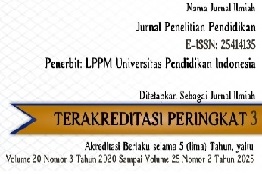Indonesian EFL Learners’ Responses To Extensive Reading: Benefits and Challenges
Abstract
Abstrak
Karena manfaatnya terhadap banyak keterampilan spesifik, ER telah dipercaya sebagai salah satu solusi terbaik dalam merangsang penguasaan bahasa siswa. Namun, terlepas dari manfaat yang ditawarkan, beberapa kendala dan masalah juga dilaporkan muncul baik dari guru maupun siswa. Studi saat ini mencoba untuk menggali (1) manfaat ER pada keterampilan spesifik yang diakui oleh mahasiswa dan (2) hambatan yang mereka hadapi dalam menerapkan ER. Penelitian ini melibatkan 4 mahasiswa Program Studi Pendidikan Bahasa Inggris di salah satu universitas di Riau, Indonesia yang telah menerapkan ER sebelum mereka masuk Universitas. Pengumpulan data dilakukan melalui angket terbuka dan wawancara. Temuan dan diskusi tentang tanggapan peserta terhadap ER kemudian disajikan dan saran untuk penelitian lebih lanjut juga diberikan.
Kata kunci: Manfaat, Tantangan, Membaca Ekstensif
Abstract
Due to its many benefits for specific skills, extensive reading (ER) has been trusted as one of the best solutions in stimulating student language acquisition. However, apart from the benefits it offers, some constraints and issues were also reported that arise from both teachers and students. The current study attempted to investigate (1) the benefits of ER on specific skills recognized by university students and (2) the obstacles they face in implementing ER. This study involved four students of an English Education Study Program at a university in Riau, Indonesia, who implemented ER before they entered the university. The data were collected through open-ended questionnaires adapted from Arai (2019) and interviews. Findings and discussions about the participants’ responses to ER are then presented, and suggestions for further research are also given.
Keywords: Benefit, Challenges, Extensive Reading.
Keywords
Full Text:
PDFReferences
Arai, Y. (2019). Extensive reading definition, effectiveness and issues concerning practice in the EFL classroom: Japanese teacher trainees’ perceptions. Journal of Extensive Reading, 7(1), 15-32.
Bell, T. (2001). Extensive reading: Speed and comprehension. The reading matrix, 1(1).
Cahyono, B. Y., Widiati, U. (2006). The teaching of EFL reading in the Indonesian context: The state of the art. TEFLIN Journal, 17(1), 23-46.
Chang, A. C., & Renandya, W. A. (2017). Current practice of extensive reading in Asia: Teachers’ perceptions. The Reading Matrix: An International Online Journal, 17(1), 40-58.
Day, R., &Bamford, J. (2002). Top ten principles for teaching extensive reading. Reading in a foreign language, 14(2), 136-141.
Henry, J. (1995). If not now: Developmental readers in the college classroom. Boynton/Cook, Heinemann.
Hufman, J. (2014). Reading rate gains during a one-semester extensive reading course. Reading in a Foreign Language, 26(2), 17-33.
Irvine, A. (2011). Extensive Reading and the development of L2 writing. First Extensive Reading World Congress, Kyoto.
Iwahori, Y. (2008). Developing reading fluency: A study of extensive reading in EFL. Reading in a Foreign language, 20(1), 70-91.
Ko, M. Y. (2013). A case study of an EFL teacher’s critical literacy teaching in a reading class in Taiwan. Language teaching research, 17(1), 91-108.
Krashen, S. (2013). The case for non-targeted, comprehensible input. Journal of Bilingual Education Research & Instruction, 15(1), 102-110.
Krashen, S., Mason, B., & Smith, K. (2018). Some new terminology: comprehension aiding supplementation and form-focusing supplementation. Journal of English Language Teaching, 60(6), 12-13.
Macalister, J. (2010). Investigating teacher attitudes to extensive reading practices in higher education: why isn’t everyone doing it? RELC Journal, 41(1), 59-75.
Macalister, J. (2015). Guidelines or commandments: Reconsidering core principles in extensive reading. Reading in a Foreign Language, 27(1), 122-128.
Medford, E., & McGeown, S. P. (2012). The influence of personality characteristics on children’s intrinsic reading motivation. Learning and Individual Differences, 22, 786–791. doi: 10.1016/j.lindif.2012.06.002
Mohd Asraf, R., & Ahmad, I. S. (2003). Promoting English language development and the reading habit among students in rural schools through the Guided Extensive Reading program.
Nation, I. S. (2008). Teaching ESL/EFL reading and writing. Routledge.
Ng, Q. R., Renandya, W. A., & Chong, M. Y. C. (2019). Extensive reading: Theory, research and implementation. Teflin Journal, 30(2), 171-186.
Nurdiyanti, E., &Suryanto, E. (2010). Pembelajaran literasi mata pelajaran Bahasa Indonesia pada siswa kelas V sekolah dasar. Paedagogia, 13(2).
Park, J. (2016). Integrating reading and writing through extensive reading. ELT Journal, 70(3), 287-295.
Prowse, P. (2002). Top ten principles for teaching extensive reading: A response. Reading in a Foreign Language, 14(2), 142-146.
Renandya, W. A., Hidayati, M., & Ivone, F. M. (2020). Extensive Reading: Top Ten Implementation Issues. JACET Journal.
Sheu, S. P. (2003). Extensive reading with EFL learners at beginning level. TESL Reporter, 36, 19-19.
Suk, N. (2016). Effects of extensive reading on motivation for reading in English. 현대영어교육, 17(4), 119-137.
Taguchi, E., Takayasu-Maass, M., & Gorsuch, G. J. (2004). Developing reading fluency in EFL: How assisted repeated reading and extensive reading affect fluency development.
Takase, A. (2007). Japanese high school students’ motivation for extensive L2 reading. Reading in a Foreign Language, 19, 1–18.
Tricomi, E. T. (1986). Krashen’s second-language acquisition theory and the teaching of edited American English. Journal of Basic Writing, 5(2), 59-69.
Waring, R., & McLean, S. (2015). Exploration of the core and variable dimensions of extensive reading research and pedagogy. Reading in a Foreign Language, 27(1), 160-167.
Webb, S., & Chang, A. C. (2015). Second language vocabulary learning through extensive reading with audio support: How do frequency and distribution of occurrence affect learning? Language Teaching Research, 19(6), 667-686.
DOI: https://doi.org/10.17509/jpp.v21i3.39871
Refbacks
- There are currently no refbacks.
Copyright (c) 2021 Jurnal Penelitian Pendidikan


